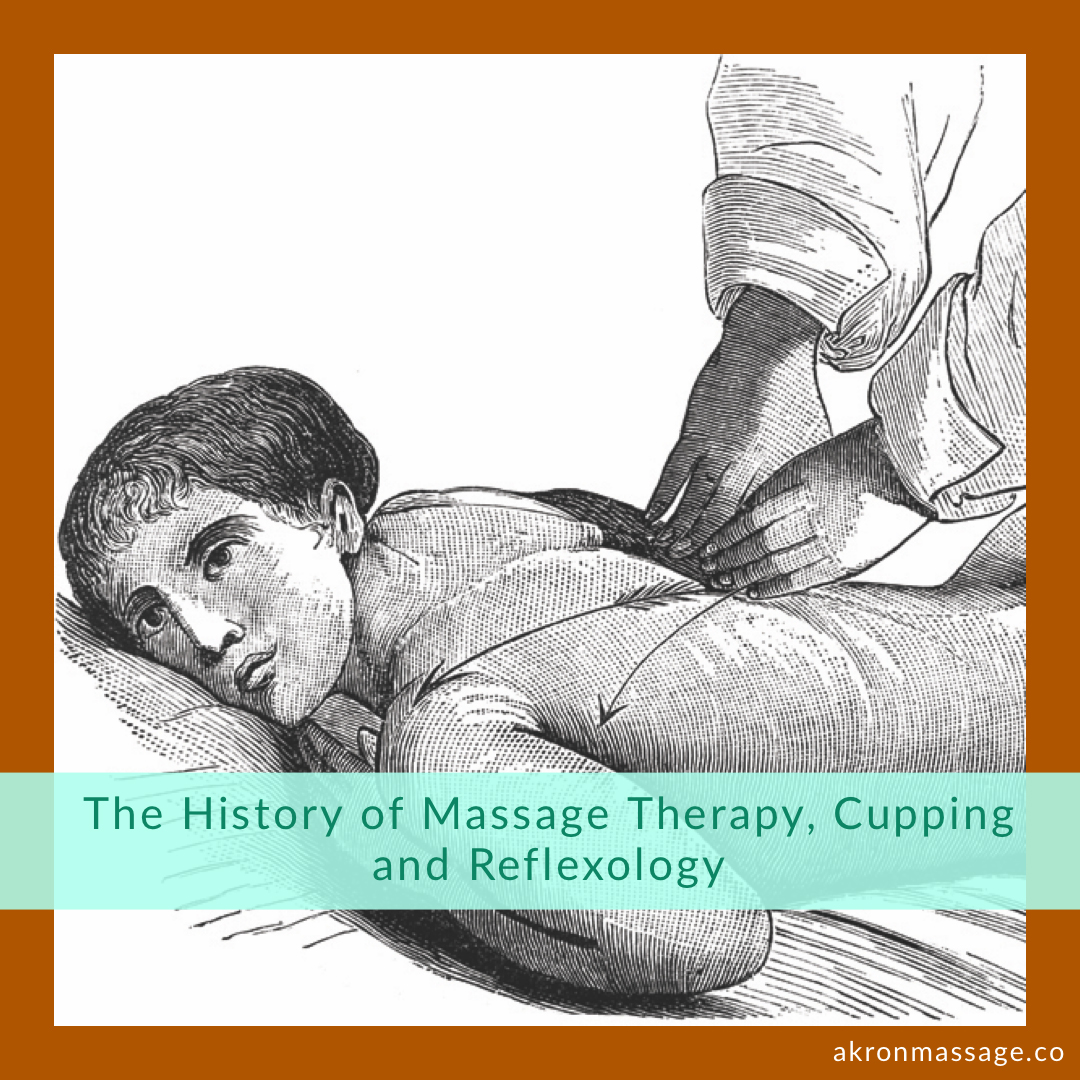For those history buffs out there I wanted to put together a brief history of some of the services that I offer.
If you would like to learn about the history of Massage Therapy, Cupping Therapy, and Reflexology please keep reading.
History of Massage Therapy
Massage therapy dates back to 2,700 BCE. It was first mentioned in the Chinese text called, “The Yellow Emperor’s Classic Book of Internal Medicine.” This book was not published in English until 1949. Massage therapy dates even further back, but this was the first mention in writing.
Many countries helped shape the practice of massage therapy as we know it today.
- Egypt (2,500 BCE)– tomb paintings show massage therapy as part of medical treatments. Also credited for developing Reflexology
- India (between 3,000 and 500 BCE)– Credited for Ayurvedic medicine
- Japan (1,000 BCE)– Credited for Traditional Chinese Medicine and Shiatsu massage
- Greece (between 800 and 700 BCE)– Athletes used massage to keep their bodies in top condition for competitions
- Rome (between 200 and 100 BCE)– followed the principles set by Hippocrates, which stated that exercise, a healthy diet, rest, and massage were necessary to maintain and restore the body’s health and well-being.
Massage as a medical practice declined between the Roman Empire and the 1600s. Between the 17th and 19th century massage spread throughout the rest of the European world.
Massage therapy didn’t become popular in Western culture until the 1800s. It all started with Swedish doctor Pehr Henrik Ling when he developed The Swedish Movement System. This system became the foundation for Swedish Massage used today. This is the most popular massage in the Western world.
Massage therapy has grown in popularity through the 20th century for those seeking an alternative option other than western medicine to heal the body without drugs. Many World War I soldiers that suffered from Post Traumatic Stress Disorder (PTSD) and nerve injuries were treated with massage. However, it wasn’t considered a mainstream treatment as it was reserved for the wealthy.
History of Cupping Therapy
Throughout history, cupping originating as a form of folk medicine, the Egyptians, Chinese, Unani, Korean, Tibetan, and Latin American cultures cupping techniques and styles have often resembled the geographic locations they were practiced in, as well as utilizing a region’s local materials. The first mentioned record was by ancient Egyptians and Chinese doctors. At this time the cups were made of cattle horns that the practitioners suctioned to the body by use of their mouths. This evolved into using what they had available including, bamboo, ceramic, glass, metal, and plastic cups.
- Chinese, Shang Dynasty (between 1600 and 1046 BCE)- Traditional Chinese Medicine- balances energy disturbances within the meridian system of the body to increase Qi (pronounced Chi) within the body.
- North Africa (1550 BCE)– Cupping therapy was first documented on Eber’s papyrus where a cup is in the Egyptian glyph to reference a physician.
- Asia, during the Jin dynasty, Ge Hong (between 281 and 341 CE)– Animal horns were used as a means of draining fluids from the body.
- Arabic and Islamic (1025 CE)- Hijama (known as wet cupping) was recommended to treat menstrual conditions.
History of Reflexology
- Egypt (2330 BC)- Pictograph on the tomb of Ankhomar at Saqqara
- Chinese (1000 BC)- “The Yellow Emperor’s Classic of Internal Medicine” was written. A chapter called “Examining Foot Method” discusses the connection of Qi (“chi” – life force) and the reflex areas on the feet.
- Marco Polo (1300’s)- Translated a Chinese massage book into Italian, introducing reflexology and massage to Europe.
- Dr. Adamus and Dr. A’tatis (1592)- wrote a book on Zone Therapy
- Dr. William H. Fitzgerald, MD, and Dr. Edwin Bowers, MD (1917)- wrote “Zone Therapy or Relieving Pain in the Home”. Two years later, they expanded this book and published it under a second title “Zone Therapy or Curing Pain and Disease”.
- Dr. Shelby Riley- expanded the work of Dr. Williams Fitzgerald by developing a map of horizontal zones going across the body and a detailed map of reflex points on the hands and feet.
- Dr. Eunice Ingham- published reflexology charts and her two books: “Stories The Feet Can Tell” (1938) and “Stories The Feet Have Told” (1951). Also established the “National Institute of Reflexology”.
- Dr. Paul Nogier (1957)- created a reflex map of points on the outer ear. Wrote the book, “The Man in the Ear” in 1959.
What was the most interesting historical fact that you just read? Mine was definitely all the different items they used for cupping.
Schedule your appointment here.

